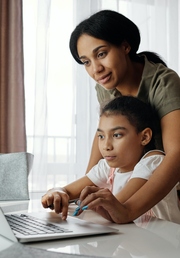Teaching Kids to Code a Website from Scratch – A Complete Guide
Kids should learn coding from an early age, and it’s not just about future career prospects. It’s also about allowing them a new form of creative expression. Not every child will be interested in pursuing the skill, but by the time those who are excited by the idea of coding discover it, they will have lost those valuable early years of learning.
This is why it’s important to expose children to the very basics of what coding is? Explaining the building of a website is a great way to introduce kids to the subject. The analogy can also be related to the online games they may play.
Laying the Foundation
Understanding the basics does not have to mean teaching the actual basics. Afterall, to beginners (young or old) coding is a complicated craft. The first step is to explain what coding actually is and why it’s important.
Use everyday examples that relate to their experiences. Explain that coding is the computer language behind what they see. Such as the design behind Lego structures or creating art in real life, except that it’s done within a computer.
Breaking Down HTML
Everything begins with HTML, which stands for hyper Text Markup Language. Explain how HTML acts like the skeleton of a website, providing structure and order. You can create an analogy by comparing website elements with building blocks.
Here are some key points you might want to cover:
- The concept of tags being at the core of HTML. At a very basic level the < and > symbols open and close things. For example, <a title>. Now, if you want to make the title bold you do this: <b>Title</b>
- Explain how opening and closing tags define different parts of a webpage like headers, paragraphs, or images.
- Tags also define hyperlinks, which are paths that allow a link to go to another page or website when clicked.
Things get more complicated when explaining hosting and virtualization concepts and solutions, like OpenVZ and KVM. Draw imaginary scenarios where their coded websites reside on computer servers powered by such technologies so they’re accessible from anywhere in the world!
This is certainly complex. But the goal for beginnings is for them to get a general idea of how things work in coding and that people who learn the language can do amazing things on websites and within games.
Making It Fun with CSS
Once kids understand the basic idea that HTML is the unseen structure behind web pages, it’s time to add some color and styles using Cascading Style Sheets (CSS). Picture it as giving their websites a colorful paint job.
Key points you can address include:
- The idea of how using CSS can style textual content and manipulate layout designs, much like a painter using different brushes and colors to create a visually compelling picture.
- Concepts such as classes, ids, values, and properties that put the magic into their web design. These are ideas that kids will learn should they decide to learn how to code through a beginning class.
Engaging kids in the hands-on exercise of drawing and coloring a web page of their own creation on paper. Teach them that the same thing is done on a computer through coding.
Unleashing Creativity with JavaScript
After HTML and CSS, it’s time to incorporate the idea of interactivity into the child’s imaginary website using JavaScript. There are many popular coding languages that allows websites to respond like magic at the click of a button!
Different languages means is more than one way to build a website. Students of coding will learn the basics of each, but the exciting thing is they can specialize in the type of coding they like best.
Important points include:
- The basics of what JavaScript is and how it makes a static webpage interactive.
- Explain how in-built functions using JavaScript can engage the user, not unlike how an online game moves and changes as they play, while a basic website with an article is still.
- Not all websites use JavaScript, but most use it some it in some way to make things more compelling.
Essentially, these ideas communicate to kids that coding is not just boding text. They can also have a lot of fun with creativity by learning to implement cool effects, from pop-up alerts to animations!
Coding Challenges
Coding isn’t always a smooth ride. Encountering errors and roadblocks is part of the learning journey and teaches problem-solving skills.
Key points to discuss at this stage include:
- Coding is a challenge, but just like building blocks are placed one-by-one to build a tower, learning works the same way. Children who want to learn how to code are introduced to concepts in an easy to understand way.
- Many children are introduced to concepts without them even knowing it. Games like Minecraft, Roblox, and LEGO Mindstorms
- Specific coding learning games like Scratch, CodinGame, and Hopscotch have been developed to go beyond the basics and keep kids engaged with more advanced basics.
Final Thoughts
Learning to code will help boost a child’s confidence while honing their analytical abilities. Following these steps helps you enable your child’s first steps into the world of coding. Keep nurturing their interests and encourage regular practice at what they enjoy doing. It’s not about perfection but progression.
Whether it’s just for fun or becomes a lifelong career, may this journey empower kids to unlock a new universe of possibilities through their newly acquired basic introduction to coding and the creative fun it offers.




